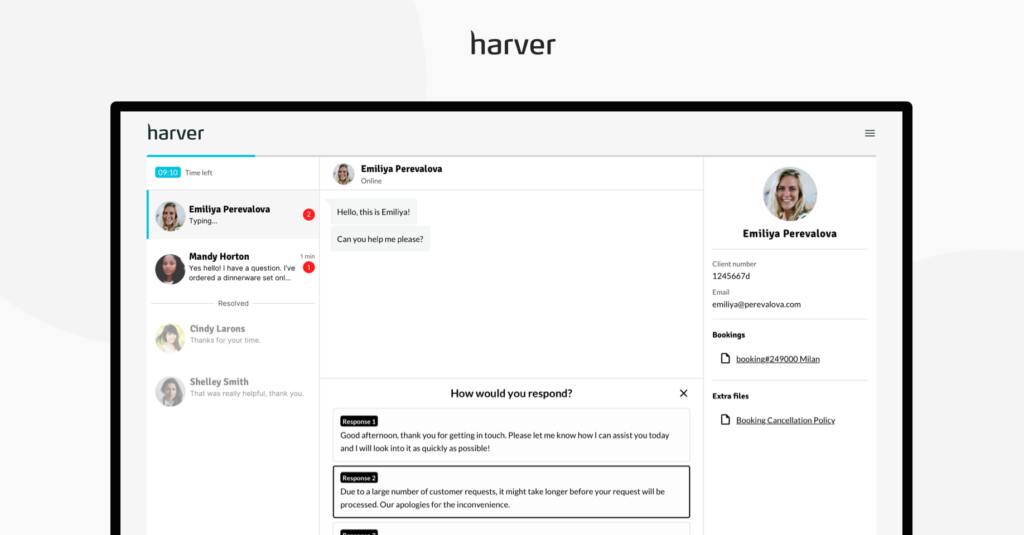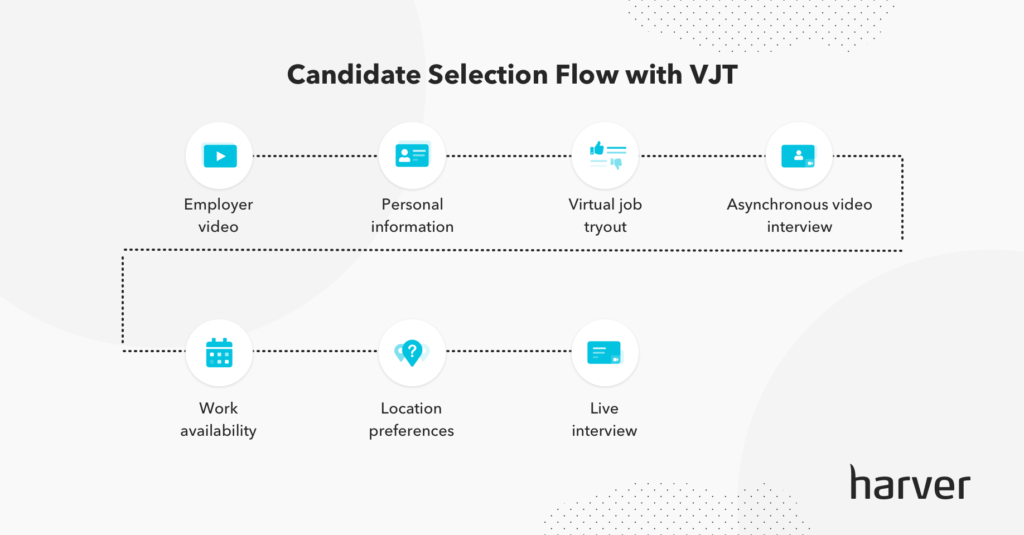In volume hiring, you can’t rely on resumes to help you find the best candidates for your roles. When you’re hiring for entry-level positions, great candidates won’t always have previous work experience, and skills matter more than a candidate’s work history for these types of roles.
Another common challenge in volume hiring is that attrition tends to be higher than average because candidates don’t fully understand what the role entails when they accept a job offer. They enter the contract blindly, only to end up quitting just days after onboarding because the role doesn’t match up with their expectations.
This is where using realistic job previews like virtual job tryouts (VJTs) and situational judgment tests (SJT) can massively improve your interview process, helping you make better-fit hires when you’re recruiting at scale.
In this guide, we’re going to take a look specifically at the virtual job tryout as a form of pre-employment assessment and how you can start using them in your recruitment process to make better hiring decisions in less time while managing candidate expectations from the start.
But first, what actually is a virtual job tryout assessment?
What’s in?
Like what you see?
Don’t miss out. Subscribe to our quarterly digest to get the latest TA and TM resources delivered right to your inbox.
What is a virtual job tryout?
Virtual job tryouts (VJT) are a type of online job simulation that mimics the main tasks of a role to give candidates a taste of what their new job will look and feel like before they start.
VJTs are a type of realistic job preview that can be brought in as part of a job application process. They provide candidates with a realistic simulation of the role and work environment, while at the same time giving employers the opportunity to track and assess how well they will cope with the main tasks they’ll be performing daily if they’re hired.
Essentially, virtual job tryouts allow the candidate to learn about the job while you learn about them!
Virtual job tryouts are used most commonly for high-volume entry-level roles like call centers and BPOs that require candidates to be skilled in certain tasks that a resume could tell you nothing about. If you’re hiring for live chat support workers, how will you know if the candidate can perform tasks like data entry, ensure data accuracy and look up account information at the level and speed you need them to?
By using a game-like simulation of these tasks, you can reliably assess multiple candidates at once and use the data to benchmark each candidate against your current best performers.
Below you can see what Harver’s Live Chat Support Simulation VJT looks like. The candidate gets to experience the role, while you’re evaluating their skills and job fit. At the same time, you’ll be creating an engaging virtual world for the candidate so they get a sneak peek into what their new job might be like.

As much as 60% of employees who leave a company within the first six months is because of misaligned expectations; the job turns out to be too difficult or not as interesting as they thought. Virtual job tryouts are the perfect solution to managing the candidate’s expectations so they know exactly what role they’re walking into on start date.
Hire better live chat agents, at scale.
Dive into the rise of live chat, the skills of top-performing agents, and how to best assess them to reduce attrition and guarantee top-notch customer service.

How to implement a virtual job tryout
Creating your own virtual job tryout that’s specific to your organization is possible to do, but it would take a lot of time and resources to build your own VJT in-house. The easiest solution is to choose a pre-employment assessment technology provider who offers VJTs already as part of their hiring tech.
For BPOs and Contact Centers engaged in volume hiring, Harver offers a Live Chat Support Simulation module that’s designed and engineered to assess the skills and characteristics linked with top performance in such roles. By identifying the key tasks that are essential to most call centre jobs, this module helps organizations hire better candidates, increasing the quality of hire and decreasing attrition in the long run.
When the labor market is tight, you want to attract as many candidates as possible to your roles, and move them through your recruitment funnel as quickly as possible. Using virtual job tryouts in your application process can help you speed up hiring substantially while providing a great candidate experience at the same time.
Adding a VJT keeps the hiring process much shorter and ensures higher application completion rates, without sacrificing depth of assessment. For example, you could create an application process that includes just the following:
- Step 1: Company video – showcase the work environment and tell the candidate a bit about the role and the organization, to establish a connection.
- Step 2: Candidate detail form – the job seeker fills out some basic personal details that registers them with an online profile in the system.
- Step 3: Virtual job tryout – the candidate gets a taste of the role and you assess their work style and ability to perform the required tasks.
- Step 4: Location and schedule preferences – the candidate indicates their availability so the system can match them to the right vacancy.

You can add a video interview in the process, but make sure you follow best practices, as this type of assessment can deter candidates. So for example, make it clear who will review the video answers – will it be your talent team, or AI? When will this happen, and when can candidates expect a follow-up message? How will their answers impact their overall assessment score? And so on.
If you need to filter more candidates out of your application process, virtual job tryouts are effective for that too. By using the VJT in combination with a personality questionnaire as your pre-employment assessment, this multimethod approach will help you filter out any candidates who might perform well in the job simulation but aren’t going be a right fit for your organization.
This reduces the likelihood that the candidate would churn soon after starting their new job, which costs the business more money in the long-term.
Differences between VJTs and other assessments
There are many different types of pre-employment assessments you can use in your interview process to find the right candidates for your roles.
So, you might be wondering what makes virtual job tryout assessments so special? The simple answer is that VJTs offer more: more insight, more interaction, more data, and better hires as a result.
They also offer a sophisticated two-way hiring experience for both the candidate and employer, which other forms of assessment aren’t able to offer.
For example, including assessments like personality questionnaires in your interview process is always a great idea, but these are really only beneficial to the employer. Candidates simply answer questions that give hiring managers insight into their character – they don’t provide any insight for the candidate about what the role might be like. Adding a VJT to supplement a personality test brings the process alive for the candidate too.
As we covered earlier in this guide, CVs and cover letters also just don’t work as a reliable form of pre-employment assessment for entry-level roles. For one thing, you’ll be missing out on excellent candidates if you rely on CVs for these types of roles, as many candidate who boast the right skills won’t have any work history yet to go on a resume.
Being able to write a good cover letter also doesn’t tell you anything about whether a candidate will be successful in a warehouse role or managing a help desk. You need solid hands-on proof that the candidate will perform well in the job, and a virtual job tryout is the perfect way to do this.
Whether in-person or video, job interviews are also less effective at assessing a candidate’s skills than a job-related assessment. Interviews can also be biased due to human decision-making, whereas virtual job tryouts are scientifically built to measure specific facets of personality and particular skills.
Research has shown us that candidates themselves consider virtual job tryouts less biased and more accurate than other forms of assessments and screening tools too, because they’re so focussed on the job rather than the individual.
If you’d like to see how Haver can transform your hiring process,
book a demo here!
Do’s and Don’ts when using VJTs
To make sure you’re on the right track when bringing a virtual job tryout into your volume hiring process, consider the following do’s and don’ts:
– Do make sure the assessment you’re using in your VJT is scientifically validated to measure the skills and characteristics linked with top performance in the role you’re hiring for. Harver works with a team of in-house io-psychologists when creating all pre-employment assessments to ensure data accuracy.
– Don’t use out-of-the-box solutions if you have a budget for custom ones – the closer you can get to the reality of the role you’re recruiting for, the better your hires will be.
– Do make VJTs mobile compatible wherever possible. However, make candidates aware that, as they won’t be performing the tasks on a smartphone if they’re successful, taking the assessment this way might not give them the full picture and could even put them at a disadvantage when up against candidates taking the assessment on desktop.
– Don’t spend time and resources trying to create your own virtual job tryout in-house. To ensure data accuracy, work with a hiring technology that offers VJTs already.
– Do benchmark against your existing high performers in the role you’re hiring for. Good performers in one role won’t be the same in another, so it’s important to use an online assessment that grades candidates on what you actually need.
– Don’t try to make the role seem easier than it is in your VJT in the hope of making it easier to get candidates in the door. This will only lead to the candidate churning quickly when they realise the job is more difficult than they were lead to believe.
– Do brand up your virtual job tryout so that it looks and feels similar to what the candidate will experience when they begin the job. This provides a sense of job security and reduces attrition as they’ll know what exactly to expect.
Next steps
Virtual job tryouts are essentially like inviting a candidate in for a trial shift, but better: Rather than using your own judgement to decide whether they’re performing well on the day, you can leave that to the technology.
All the candidate needs is a good internet connection, and you’ll be able to gather invaluable insights on their skills and performance that you can use to make those difficult hiring decisions for you.
If you’d like to see Harver’s virtual job tryouts in action, and get a taste for how this sophisticated technology will land you your best hires, you can check the demo below.
Experience our best-in-class Live Chat Assessment first-hand!
Perfect for remote hiring, our live chat assessment makes it easier than ever to hire live chat agents. Candidates experience the job, while you get actionable data to drive hiring decisions.


